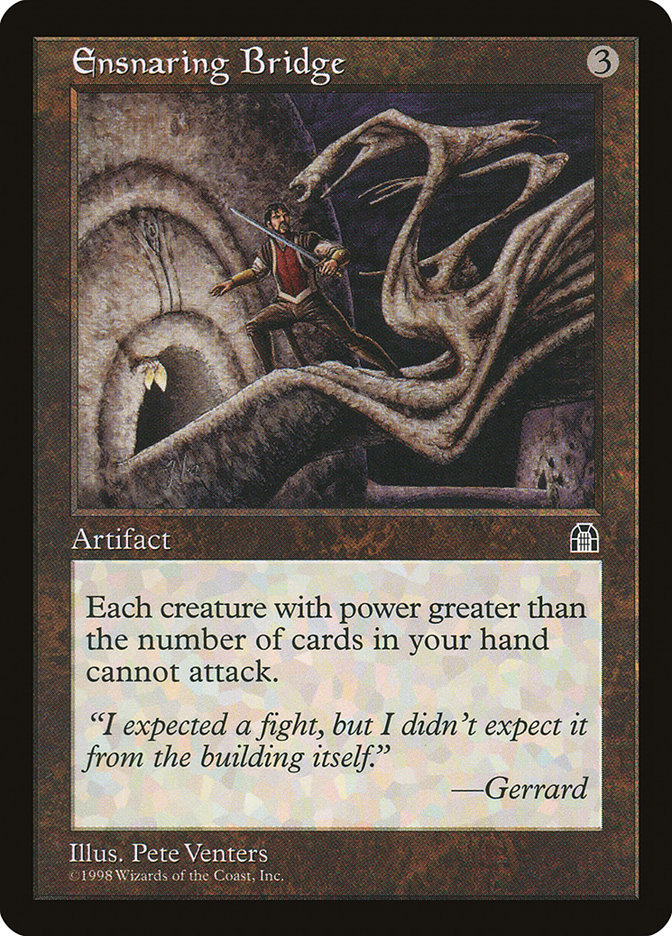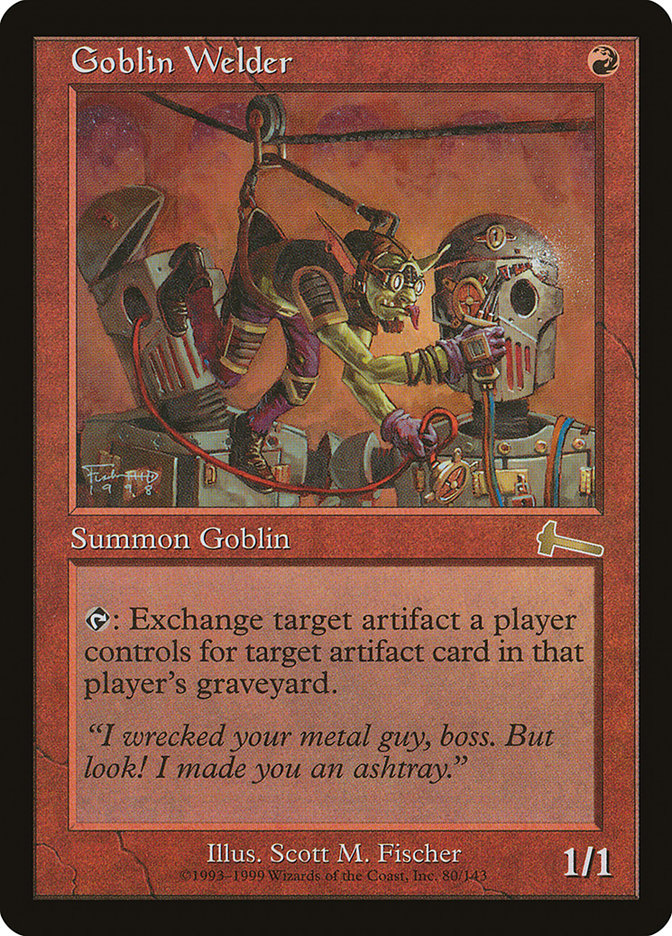Painting Stones
DDDDDDDDDDDDJJJJJJJJJJJJJJJJJJJJ Khalid!!!!
"’Cause I’m out here grindin’."
I win the die roll and proceed with an Ancient Tomb, taking two damage to cast Painter’s Servant on blue, and pass the turn. My opponent takes his first turn, playing a Badlands and dropping down a Deathrite Shaman. I begin my second turn by playing a City of Traitors. I tap all my lands and cast a Grindstone, then with the extra three colorless mana, I activate it to deck my opponent.
That’s pretty much how Painted Stone tends to operate. In fact, it’s been winning a lot as of late. Take the two most recent SCG Legacy Opens for example:
Creatures (19)
- 1 Goblin Welder
- 4 Imperial Recruiter
- 1 Jaya Ballard, Task Mage
- 4 Simian Spirit Guide
- 2 Magus of the Moon
- 4 Painter's Servant
- 2 Phyrexian Revoker
- 1 Spellskite
Lands (11)
Spells (30)

Creatures (18)
- 1 Goblin Welder
- 4 Imperial Recruiter
- 1 Jaya Ballard, Task Mage
- 4 Simian Spirit Guide
- 2 Magus of the Moon
- 4 Painter's Servant
- 1 Phyrexian Revoker
- 1 Spellskite
Planeswalkers (2)
Lands (20)
Spells (20)

This two-step process is a pretty easy thing to accomplish and can be done as early as turn 2. The only things a deck like this really struggles with is decks that are capable of consistently disrupting your combo and decks with shuffle effects such as Emrakul, the Aeons Torn. Looking at the deck, you can see there really isn’t anything it can do against Sneak and Show. I tend not to believe in the idea of conceding to a deck, but this is especially true when that deck is one of the more popular ones in the format.
In a world not so long ago, when SCG made its rounds to Orlando, Florida and GerryT was still grinding the circuit, he narrowly stopped me in the semifinals of a Legacy Open. I was piloting the Painted Stone deck I had been working on. I’ve played the deck a lot and know it inside and out. The cutest thing you can do is name blue with Painter’s Servant and then use Force of Will, exiling a land. With all the work I put into the deck, my main goal was defeating the flying spaghetti monster.
Creatures (10)
Lands (22)
Spells (28)

Having access to the Bomberman combo out of the sideboard meshes well with the deck’s synergies and is a huge turn on. If it hasn’t quite clicked yet, here’s what you do:
Step 1: Resolve Auriok Salvagers.
Step 2: Have a Lion’s Eye Diamond + Pyrite Spellbomb.
Step 3: Generate Infinite Mana with Salvagers/LED, do Infinite Damage with Pyrite Spellbomb.
Pretty neat, huh? I’d often accomplish step 1 or step 2 and be trying to find whichever I was missing. Intuition and Trinket Mage were a big part of that and a big draw to include blue. Since that event, I really haven’t dabbled too much into Legacy and have stuck to pretty much every other format. When I have played Legacy, I have opted to play decks like Reanimator or Shardless BUG because they’re considered to be relatively safe choices.
Painting Bombs
However, safe isn’t always correct. As a matter of fact, safe is rarely the correct choice. Sure, you give yourself a pretty good chance of posting a solid record if you’re playing the number one deck of the format and you make good decisions all day. But if you’re doing what most other people are doing, at some point it’s going to come down to a coin flip or die roll to determine a match or two. I’m not suggesting that you should always play a rogue deck but rather that you should try to find a deck that matches up well against the rest of the field. Because odds are that if you’re playing the safe deck, it’s because you haven’t done enough testing.
Easier said than done, I know.
It’s hard to find the time to put in the extra effort. But that deck is out there 90% of the time—you just have to find it. In pursuit of said deck in Legacy, I have been toying with Painted Stone. I wanted to incorporate both combos and find a balance that makes sense. I also didn’t want to make the deck too convoluted with too many combo cards and not enough interaction. I’m looking to be redundant yet still diverse enough that one card isn’t just a straight trump to the entire deck. This is where I am as of today:
Creatures (15)
Lands (20)
Spells (25)

2 Cavern of Souls: Against blue decks, if we are able to resolve an Auriok Salvagers, then the other combo pieces necessary to work with it won’t matter if they get countered. The Salvagers can just bring them back again and again until they’re dead. It just so happens that both Imperial Recruiter and Salvagers are Humans, which makes for an excellent way to bridge ourselves into the combo.
4 Enlightened Tutor: This gives us whatever we are looking for to complete whichever half of the combo we are going for. This is a pretty obvious choice to include.
4 Lion’s Eye Diamond: Four admittedly is a lot, but it is a piece required to win with Salvagers and also helps you activate the Grindstone a turn early if you’re going that route.
3 Mox Opal: The Opal gives us both ramp and fixing. It isn’t absolutely necessary but helps a lot when you’re trying to race opposing combo decks.
4 Pyrite Spellbomb: This is a really diverse card that is extremely important. Against control, it’s just a cantrip. But against aggressive decks like RUG Delver, it just murders a dude, and we get to use it to kill our opponent.
1 Ensnaring Bridge: About 1% of our games we will win by attacking, and that’s being fairly generous to the 1%. Since this deck sometimes just needs to buy time to find the last piece of the puzzle, this is a perfect one-of tutor target that can simply beat some decks by itself.
1 Nihil Spellbomb: This card probably looks the most out of place. It’s here to allow us to use the Grindstone combo effectively against Emrakul. It also happens to help against Dredge. The reason I’m opting for this over something like Tormod’s Crypt is that it cycles using the Opal. This is especially useful if we have a Goblin Welder in play.
2 Sensei’s Divining Top: The reason this isn’t a four-of is that we don’t have a ton of shuffling effects. Drawing multiple Tops can be a burden without those effects. The one good thing about the Top is just like Nihil Spellbomb it cycles very well with Goblin Welder.
4 Imperial Recruiter: This guy has been popping up more and more. It’s most likely due to its reduced price from a couple of years ago. It finds either half of our creature combo pieces or gets us some protection with Spellskite.
2 Goblin Welder: Perhaps my favorite card in Legacy. When playing against disruption, this card is an absolute nightmare. When you bait out a couple of kill spells or countermagic and follow it up with a Welder, it will make for some easy wins. Much like Top, you don’t want to draw too many since it doesn’t help contribute to killing your opponent.
Currently the deck is in its infancy. I’ve tested against three archetypes so far. I played against RUG Delver, and by all accounts it has been relatively easy to beat so far. Against Esper Deathblade, I have about a 50/50 matchup. The interesting matchup is Sneak and Show. When my opponent had no clue what I was playing, I won the first nine of ten. Once he learned how to play against the deck, it was a complete 360, and I won two and lost eight. What changed was he avoided casting Show and Tell and opted to stick with just Sneak Attack. When he cast Show and Tell, I won every time. The good news is that the average opponent will Show and Tell as fast as possible every single time, so I’m not too concerned with these results.
As you can see, I have left the sideboard open since I haven’t determined what matchups are good and bad and it wouldn’t make much sense to have one until then. The only thing I know for sure is the deck is going to need access to a Disenchant type effect to deal with Leyline of Sanctity since that is something this deck cannot beat without some help.
Painting Peace
Something else I still need to figure out is if there’s a place for Rest in Peace and Helm of Obedience. Sharing a deck with Painted Stone is something that the Rest in Peace + Helm combo can do pretty well. For obvious reasons, Rest in Peace doesn’t work very well with Auriok Salvagers, so that’s out of the equation. The really good thing about Rest in Peace is that it works extremely well in conjunction with the Painted Stone combo since the one deck it really struggles with is Sneak and Show. Not to mention it helps get free wins against Dredge and incidentally is also very useful against a wide array of other popular cards like Tarmogoyf, Punishing Fire, Life from the Loam, Deathrite Shaman, and Snapcaster Mage. A mock list would look something like this:
Creatures (4)
Lands (19)
Spells (36)

I hope this got your brain ticking about just some of the possibilities that Legacy has to offer. With little effort, I came up with two fairly fresh ideas based solely on two-card combos. Having some legitimacy behind the idea based on recent results makes me even more confident that these could be the right direction for the deck to go. We’ve got a Legacy Grand Prix in a couple of months in Washington, D.C., and I’m really looking forward to going. But only one thing is for certain:
I’ll be out there grindin’.
Gosu. on Magic Online
@JCuvelier on Twitter


